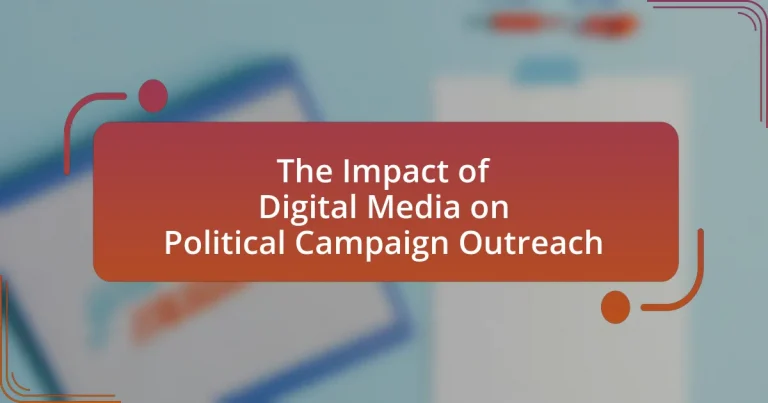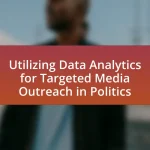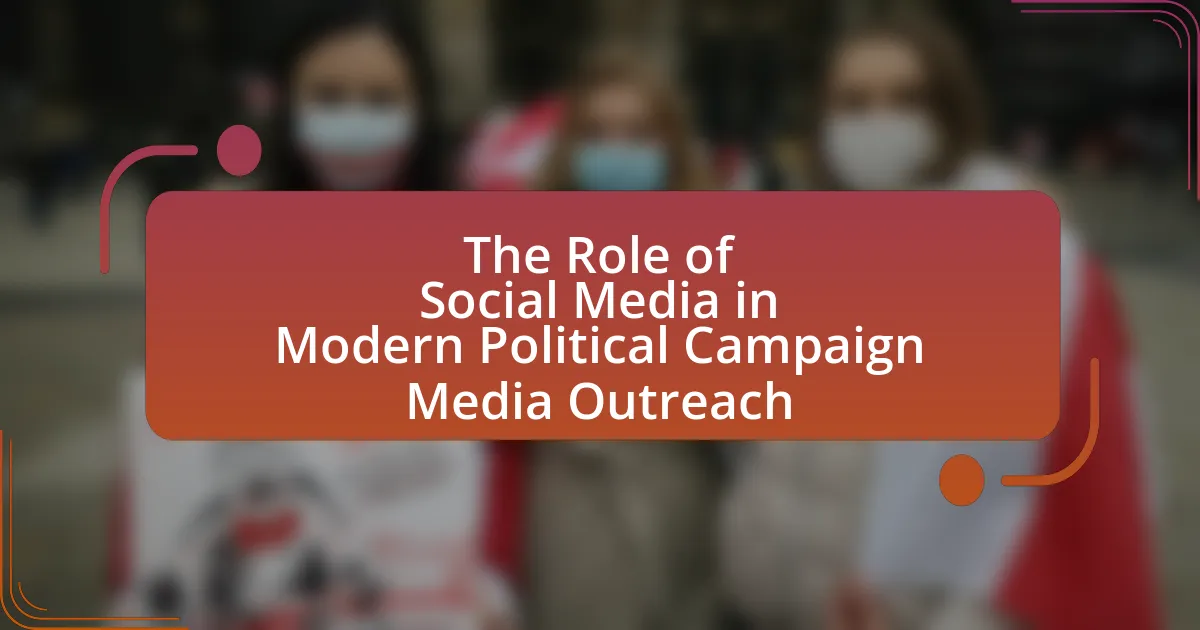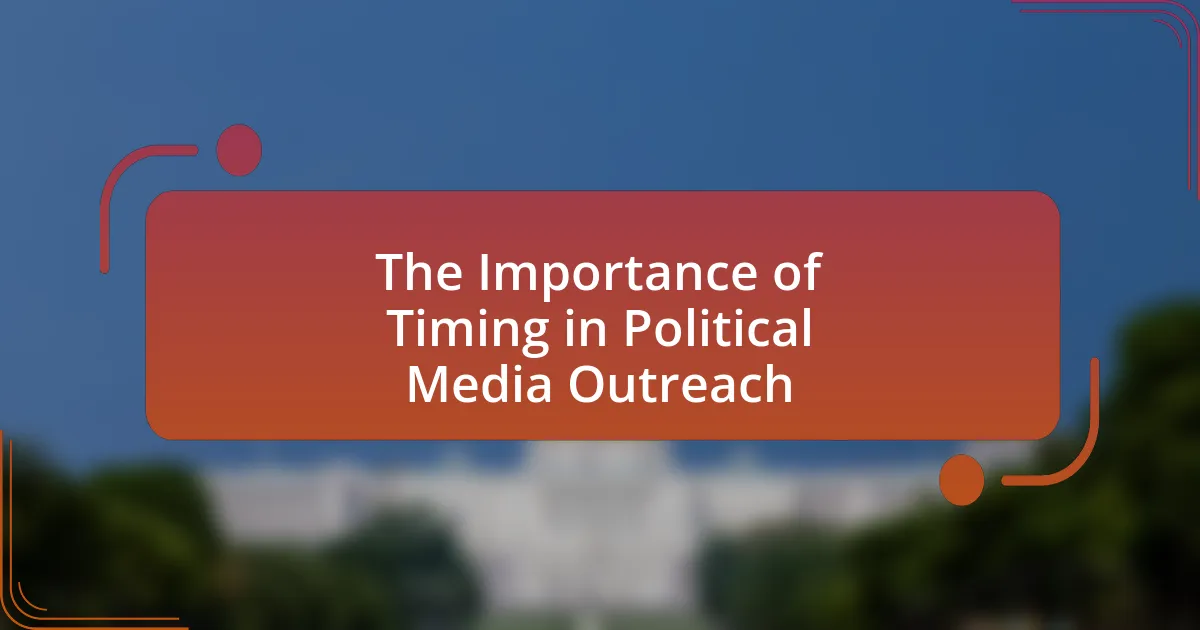The article examines the significant impact of digital media on political campaign outreach, highlighting how platforms such as social media, email, and websites facilitate targeted communication and real-time engagement with voters. It discusses the transformation of campaign strategies through data analytics, enabling personalized messaging that resonates with diverse demographics. Key digital platforms like Facebook, Twitter, and Instagram are analyzed for their roles in enhancing voter engagement and mobilization. The article also addresses challenges such as misinformation and privacy concerns, while emphasizing best practices for effective digital content creation and audience interaction. Overall, it underscores the essential role of digital media in modern political campaigning and its influence on voter behavior.
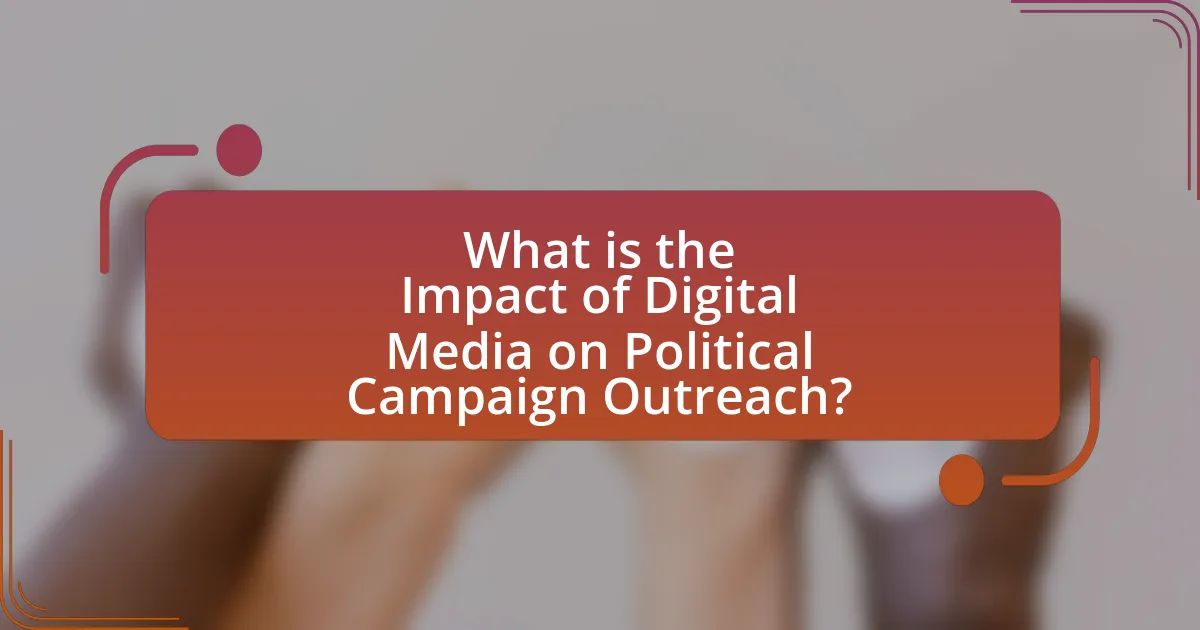
What is the Impact of Digital Media on Political Campaign Outreach?
Digital media significantly enhances political campaign outreach by enabling targeted communication and real-time engagement with voters. Campaigns utilize platforms like social media, email, and websites to disseminate information quickly and efficiently, reaching diverse demographics. For instance, a study by the Pew Research Center found that 69% of adults in the U.S. use social media, making it a crucial tool for campaigns to connect with potential voters. Additionally, digital media allows for data analytics, enabling campaigns to tailor their messages based on voter preferences and behaviors, thereby increasing the effectiveness of outreach efforts.
How has digital media transformed political campaign strategies?
Digital media has transformed political campaign strategies by enabling targeted communication and real-time engagement with voters. Campaigns now utilize social media platforms, data analytics, and digital advertising to reach specific demographics, allowing for personalized messaging that resonates with individual voters. For instance, the 2008 Obama campaign effectively used social media to mobilize supporters and gather donations, resulting in over $600 million raised online. Additionally, digital media facilitates rapid response to political events, allowing campaigns to adapt their strategies almost instantaneously, which was evident during the 2016 election when candidates used Twitter to address controversies and engage directly with the electorate. This shift has fundamentally changed how campaigns operate, making them more data-driven and interactive.
What are the key digital media platforms used in political campaigns?
Key digital media platforms used in political campaigns include Facebook, Twitter, Instagram, YouTube, and TikTok. These platforms enable candidates to reach a broad audience, engage with voters, and disseminate campaign messages effectively. For instance, Facebook has over 2.8 billion monthly active users, making it a crucial tool for targeted advertising and community building. Twitter allows for real-time communication and updates, while Instagram’s visual content appeals to younger demographics. YouTube serves as a platform for video storytelling, and TikTok has emerged as a space for creative and viral campaign content, particularly among Gen Z voters.
How do these platforms influence voter engagement?
Digital media platforms significantly influence voter engagement by facilitating direct communication between candidates and voters. These platforms enable candidates to share their messages widely and interactively, allowing for real-time feedback and discussions. For instance, studies show that social media campaigns can increase voter turnout by up to 10% by mobilizing younger voters who are more active online. Additionally, targeted advertising on these platforms allows campaigns to reach specific demographics, enhancing the relevance of their messages and increasing the likelihood of voter participation.
Why is digital media essential for modern political campaigns?
Digital media is essential for modern political campaigns because it enables direct communication with voters, enhances engagement, and allows for targeted messaging. In the 2020 U.S. presidential election, for instance, candidates utilized social media platforms to reach millions of potential voters quickly and effectively, with over 70% of voters reporting that they received campaign information through social media. This direct access facilitates real-time feedback and interaction, fostering a sense of community and involvement among supporters. Additionally, digital media allows campaigns to analyze voter data and tailor their messages to specific demographics, increasing the likelihood of voter mobilization and support.
What advantages does digital media offer over traditional media?
Digital media offers several advantages over traditional media, including greater reach, interactivity, and cost-effectiveness. Digital platforms can engage a global audience instantly, as evidenced by the fact that over 4.9 billion people use the internet, allowing political campaigns to target specific demographics more efficiently than traditional media, which is often limited by geographic boundaries. Additionally, digital media enables two-way communication, allowing voters to interact with campaigns through social media, which fosters engagement and feedback. This interactivity is supported by statistics showing that 70% of voters engage with political content on social media. Furthermore, digital advertising is generally more affordable than print or broadcast advertising, with campaigns able to allocate budgets more flexibly and track performance in real-time, leading to more effective outreach strategies.
How does digital media enhance communication with constituents?
Digital media enhances communication with constituents by providing immediate access to information and facilitating two-way interactions. Platforms such as social media, email, and websites allow political entities to disseminate messages quickly and engage directly with constituents, fostering a sense of community and responsiveness. For instance, a study by the Pew Research Center found that 69% of adults in the U.S. use social media, which enables politicians to reach a broader audience and receive real-time feedback on policies and initiatives. This immediacy and interactivity strengthen the relationship between political representatives and their constituents, making communication more effective and inclusive.
What challenges do political campaigns face with digital media?
Political campaigns face several challenges with digital media, including misinformation, data privacy concerns, and the rapid pace of information dissemination. Misinformation can spread quickly on social media platforms, undermining campaign messages and creating confusion among voters. Data privacy concerns arise from the collection and use of personal data for targeted advertising, leading to potential backlash from voters who feel their privacy is compromised. Additionally, the rapid pace of information dissemination means that campaigns must constantly adapt their strategies to respond to emerging narratives and trends, which can strain resources and complicate messaging. These challenges require campaigns to be vigilant and proactive in managing their digital presence and engaging with voters effectively.
How do misinformation and fake news impact political outreach?
Misinformation and fake news significantly undermine political outreach by distorting public perception and eroding trust in political institutions. Research indicates that exposure to false information can lead to misinformed voting decisions, as seen in the 2016 U.S. presidential election, where 62% of Americans reported encountering fake news online. This prevalence of misinformation can skew the effectiveness of political messaging, as voters may base their opinions on inaccurate narratives rather than factual information. Consequently, political campaigns face challenges in engaging with constituents, as the spread of false information complicates the communication of their platforms and policies.
What are the privacy concerns associated with digital campaigning?
Privacy concerns associated with digital campaigning primarily involve the collection and use of personal data without explicit consent. Campaigns often utilize data analytics to target voters based on their online behavior, which raises issues regarding data security and potential misuse of sensitive information. For instance, the Cambridge Analytica scandal highlighted how personal data from millions of Facebook users was harvested and used for political advertising without their knowledge, leading to widespread public outcry and calls for stricter regulations. Additionally, the lack of transparency in how data is collected and utilized can erode trust between voters and political entities, further complicating the ethical landscape of digital campaigning.
How do political campaigns measure the effectiveness of digital media outreach?
Political campaigns measure the effectiveness of digital media outreach primarily through analytics tools that track engagement metrics. These metrics include website traffic, social media interactions, click-through rates, and conversion rates, which provide insights into how well the outreach resonates with the target audience. For instance, a study by the Pew Research Center found that campaigns utilizing targeted ads on social media platforms saw a 20% increase in voter engagement compared to those that did not. Additionally, surveys and feedback forms are often employed to gather qualitative data on voter perceptions and attitudes, further validating the impact of digital strategies.
What metrics are used to evaluate digital campaign success?
Metrics used to evaluate digital campaign success include engagement rate, conversion rate, click-through rate (CTR), return on investment (ROI), and reach. Engagement rate measures interactions such as likes, shares, and comments relative to total followers, indicating audience interest. Conversion rate tracks the percentage of users completing desired actions, such as signing up or donating, reflecting campaign effectiveness. Click-through rate quantifies the ratio of users who click on a campaign link versus those who view it, providing insight into content appeal. Return on investment assesses the financial return relative to campaign costs, essential for budget evaluation. Reach indicates the total number of unique users exposed to the campaign, crucial for understanding audience size. These metrics collectively provide a comprehensive view of a digital campaign’s performance and impact.
How can campaigns adjust strategies based on digital media analytics?
Campaigns can adjust strategies based on digital media analytics by analyzing engagement metrics, audience demographics, and content performance to refine their messaging and targeting. For instance, if analytics reveal that a particular demographic engages more with video content, campaigns can increase video production to cater to that audience. Additionally, tracking click-through rates and conversion metrics allows campaigns to identify which messages resonate most effectively, enabling them to pivot their strategies in real-time. Research from the Pew Research Center indicates that 69% of adults in the U.S. use social media, highlighting the importance of leveraging these platforms for targeted outreach based on analytics.

What are the trends in digital media for political campaigns?
Trends in digital media for political campaigns include increased use of social media platforms, targeted advertising, and data analytics. Political campaigns are leveraging social media to engage voters directly, with platforms like Facebook and Twitter being essential for real-time communication and mobilization. Targeted advertising allows campaigns to reach specific demographics based on data analytics, enhancing the effectiveness of their outreach. According to a 2020 Pew Research study, 69% of Americans reported using social media for political news, highlighting its growing influence in shaping public opinion. Additionally, the use of video content, particularly on platforms like YouTube and TikTok, has surged, as campaigns recognize the power of visual storytelling to connect with younger voters.
How are emerging technologies shaping political outreach?
Emerging technologies are significantly shaping political outreach by enabling more targeted communication and enhancing voter engagement. For instance, data analytics and social media platforms allow political campaigns to identify and reach specific demographics with tailored messages, increasing the effectiveness of outreach efforts. According to a study by the Pew Research Center, 69% of adults in the U.S. use social media, making it a crucial channel for political messaging. Additionally, tools like artificial intelligence and machine learning are being utilized to analyze voter behavior and preferences, allowing campaigns to optimize their strategies in real-time. This shift towards data-driven approaches has transformed traditional outreach methods, making them more efficient and impactful.
What role do artificial intelligence and data analytics play in campaigns?
Artificial intelligence and data analytics play a crucial role in enhancing the effectiveness of political campaigns by enabling targeted messaging and optimizing resource allocation. AI algorithms analyze vast amounts of voter data to identify trends, preferences, and behaviors, allowing campaigns to tailor their strategies to specific demographics. For instance, a study by the Pew Research Center found that campaigns utilizing data analytics can increase voter engagement by up to 20%, demonstrating the tangible benefits of these technologies in reaching and influencing potential voters.
How is social media evolving in the context of political engagement?
Social media is evolving in the context of political engagement by becoming a primary platform for direct communication between politicians and constituents. This shift is evidenced by the increasing use of platforms like Twitter and Facebook for real-time updates, campaign announcements, and voter mobilization efforts. According to a Pew Research Center study, 69% of adults in the U.S. use social media, which has led to more targeted political advertising and grassroots organizing. Furthermore, social media facilitates the rapid spread of information and mobilizes communities around specific issues, as seen in movements like Black Lives Matter and climate activism, demonstrating its significant role in shaping political discourse and engagement.
What impact do influencers and online communities have on political campaigns?
Influencers and online communities significantly shape political campaigns by amplifying messages and mobilizing voter engagement. Influencers leverage their large followings to sway public opinion, often leading to increased visibility for candidates and issues. For instance, during the 2020 U.S. presidential election, influencers on platforms like Instagram and TikTok played a crucial role in encouraging younger voters to participate, resulting in a record turnout among this demographic. Online communities facilitate discussions and grassroots organizing, enabling campaigns to tap into specific interests and concerns of voters. Research from the Pew Research Center indicates that 69% of adults in the U.S. use social media, making it a vital space for political discourse and mobilization. Thus, the impact of influencers and online communities on political campaigns is profound, driving engagement and shaping electoral outcomes.
How can campaigns leverage influencers for outreach?
Campaigns can leverage influencers for outreach by collaborating with them to amplify their messages and reach targeted audiences effectively. Influencers possess established trust and credibility within their communities, which can enhance the campaign’s visibility and engagement. For instance, a study by the Digital Marketing Institute found that 49% of consumers depend on influencer recommendations, indicating that influencer partnerships can significantly impact public perception and voter mobilization. By strategically selecting influencers whose values align with the campaign, campaigns can create authentic content that resonates with potential voters, ultimately driving higher engagement and support.
What are the benefits of engaging with online communities?
Engaging with online communities offers numerous benefits, including enhanced communication, increased support, and access to diverse perspectives. These communities facilitate direct interaction between political campaigns and constituents, allowing for real-time feedback and dialogue. Research indicates that campaigns utilizing online platforms can increase voter engagement by up to 30%, as they create spaces for discussion and mobilization. Furthermore, online communities enable campaigns to tap into grassroots support, fostering a sense of belonging and collective action among participants. This engagement not only strengthens campaign outreach but also cultivates informed and active citizenry, essential for a healthy democratic process.

What best practices should political campaigns follow in digital media outreach?
Political campaigns should prioritize targeted messaging, engagement with constituents, and data analytics in their digital media outreach. Targeted messaging involves tailoring content to specific demographics, which increases relevance and effectiveness; for instance, campaigns that utilize Facebook’s ad targeting features can reach specific voter segments based on interests and behaviors. Engagement with constituents through interactive content, such as polls and Q&A sessions, fosters a sense of community and encourages voter participation; studies show that campaigns with higher engagement rates often see increased voter turnout. Lastly, leveraging data analytics allows campaigns to assess the effectiveness of their outreach strategies, enabling them to adjust tactics in real-time; according to a report by the Pew Research Center, data-driven campaigns are significantly more successful in mobilizing voters.
How can campaigns create effective digital content?
Campaigns can create effective digital content by focusing on audience engagement, utilizing data analytics, and ensuring message clarity. Engaging content resonates with target demographics, fostering interaction and sharing. Data analytics allows campaigns to tailor content based on audience preferences and behaviors, enhancing relevance and impact. Clear messaging ensures that the core message is easily understood and memorable, which is crucial in a crowded digital landscape. Research indicates that campaigns employing targeted digital strategies see a 30% increase in engagement rates compared to those using generic content.
What types of content resonate most with voters online?
Visual content, particularly videos and infographics, resonates most with voters online. Research indicates that videos are shared 1,200% more than text and images combined, highlighting their effectiveness in engaging audiences. Additionally, infographics simplify complex information, making it more digestible and shareable, which is crucial in political messaging. A study by the Pew Research Center found that 64% of voters engage with political content through social media, where visual formats dominate. This data underscores the importance of utilizing engaging visual content to capture voter attention and drive online interactions.
How can campaigns ensure their messaging is clear and impactful?
Campaigns can ensure their messaging is clear and impactful by utilizing concise language, focusing on key messages, and employing targeted audience segmentation. Clear language minimizes ambiguity, making it easier for the audience to understand the campaign’s objectives. Research indicates that messages with fewer than 20 words are more likely to be remembered and shared, enhancing their impact. Additionally, focusing on core messages allows campaigns to maintain consistency across various platforms, reinforcing their identity and purpose. Targeted audience segmentation ensures that the messaging resonates with specific demographics, increasing engagement and effectiveness. For instance, campaigns that tailor their messages to the interests and values of particular voter groups have shown higher response rates, as evidenced by the 2016 U.S. presidential election, where targeted digital ads significantly influenced voter behavior.
What strategies can enhance voter engagement through digital media?
Strategies that can enhance voter engagement through digital media include targeted social media campaigns, interactive content, and data-driven outreach. Targeted social media campaigns utilize demographic data to reach specific voter groups, increasing the likelihood of engagement; for example, a study by the Pew Research Center found that 69% of adults in the U.S. use Facebook, making it a powerful platform for political outreach. Interactive content, such as polls and quizzes, encourages participation and fosters a sense of community among voters, as evidenced by campaigns that have successfully used these tools to boost engagement rates. Data-driven outreach leverages analytics to tailor messages and identify the most effective communication channels, which has been shown to improve voter turnout by up to 15% in various elections.
How can campaigns utilize interactive content to engage voters?
Campaigns can utilize interactive content to engage voters by creating polls, quizzes, and interactive infographics that encourage participation and feedback. This approach fosters a two-way communication channel, allowing voters to express their opinions and preferences while feeling more connected to the campaign. For instance, a study by the Pew Research Center found that 64% of Americans believe that interactive content makes political information more engaging, highlighting its effectiveness in capturing voter interest. By integrating such content into their digital strategies, campaigns can enhance voter engagement and build a more informed electorate.
What role does personalization play in digital outreach?
Personalization plays a crucial role in digital outreach by enhancing engagement and improving response rates. Tailored messages that resonate with individual preferences and behaviors lead to higher levels of interaction, as evidenced by a study from Epsilon which found that 80% of consumers are more likely to make a purchase when brands offer personalized experiences. This targeted approach not only fosters a sense of connection but also increases the effectiveness of political campaigns by ensuring that messages are relevant to specific voter segments, thereby maximizing the impact of outreach efforts.
What are the common pitfalls to avoid in digital media campaigning?
Common pitfalls to avoid in digital media campaigning include neglecting audience targeting, failing to engage with followers, and not analyzing campaign performance. Neglecting audience targeting can lead to wasted resources, as campaigns may reach individuals who are not interested in the message; for instance, a study by the Pew Research Center found that targeted ads significantly increase engagement rates. Failing to engage with followers can diminish brand loyalty and reduce the effectiveness of the campaign, as interaction fosters community and trust. Not analyzing campaign performance prevents campaign optimization, as data-driven decisions are essential for improving future efforts; according to HubSpot, companies that analyze their marketing data are 5 times more likely to make informed decisions.
How can campaigns prevent backlash from poorly executed digital strategies?
Campaigns can prevent backlash from poorly executed digital strategies by implementing thorough planning and continuous monitoring of their digital content. Effective planning involves setting clear objectives, understanding the target audience, and creating content that resonates with them, which reduces the likelihood of miscommunication or offense. Continuous monitoring allows campaigns to quickly identify and address any negative feedback or missteps, as evidenced by the rapid response strategies employed by successful campaigns during crises, such as the 2016 U.S. presidential election, where timely adjustments to messaging helped mitigate backlash. By prioritizing these proactive measures, campaigns can safeguard their reputation and maintain public trust.
What lessons can be learned from past digital campaign failures?
Past digital campaign failures highlight the importance of understanding target audiences, as misalignment can lead to ineffective messaging. For instance, the 2016 Hillary Clinton campaign faced backlash for its failure to resonate with key demographics, resulting in a loss of crucial votes. Additionally, campaigns must prioritize transparency and authenticity; the Cambridge Analytica scandal demonstrated how data misuse can erode public trust and damage reputations. Furthermore, the lack of adaptability in response to real-time feedback can hinder campaign effectiveness, as seen in the failed launch of the 2019 New Coke campaign, which ignored consumer sentiment. These examples underscore the necessity for thorough audience research, ethical data practices, and agile strategies in digital campaigning.
What practical tips can improve digital media outreach for political campaigns?
To improve digital media outreach for political campaigns, campaigns should focus on targeted messaging, engaging content, and data analytics. Targeted messaging ensures that the campaign reaches specific demographics effectively, as studies show that personalized content increases engagement rates by up to 50%. Engaging content, such as videos and interactive posts, can capture attention and encourage sharing, which is crucial for expanding reach. Additionally, utilizing data analytics allows campaigns to track performance metrics and adjust strategies in real-time, leading to more effective outreach efforts. For instance, campaigns that analyze social media engagement data can optimize their content based on what resonates most with their audience, resulting in a more impactful digital presence.
